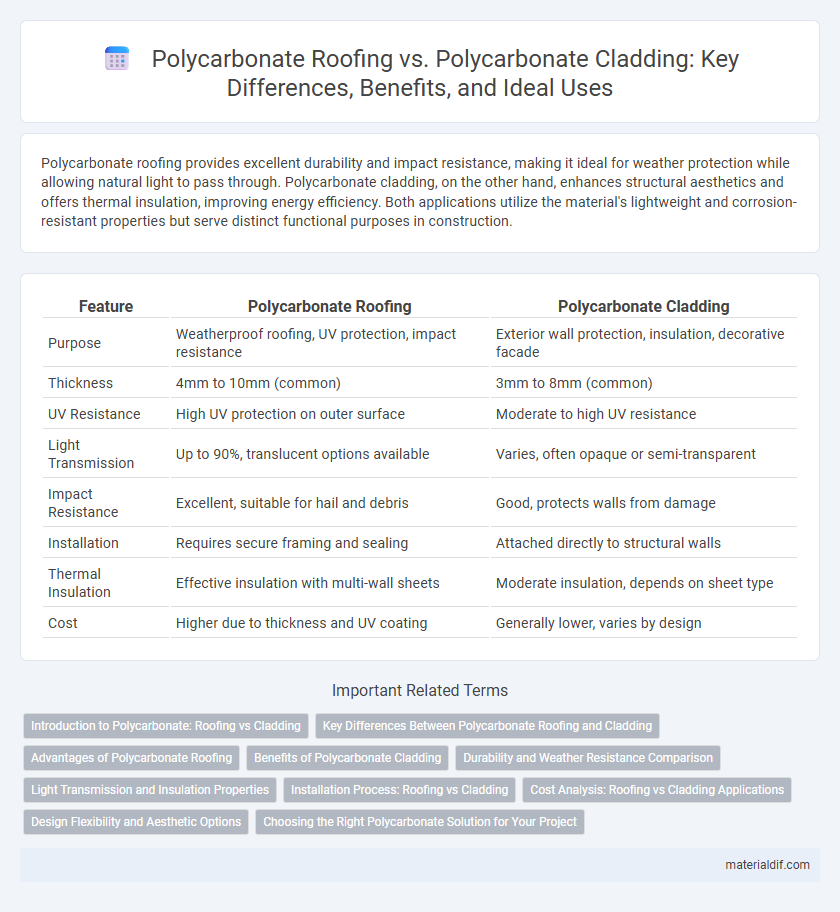Polycarbonate roofing provides excellent durability and impact resistance, making it ideal for weather protection while allowing natural light to pass through. Polycarbonate cladding, on the other hand, enhances structural aesthetics and offers thermal insulation, improving energy efficiency. Both applications utilize the material's lightweight and corrosion-resistant properties but serve distinct functional purposes in construction.
Table of Comparison
| Feature | Polycarbonate Roofing | Polycarbonate Cladding |
|---|---|---|
| Purpose | Weatherproof roofing, UV protection, impact resistance | Exterior wall protection, insulation, decorative facade |
| Thickness | 4mm to 10mm (common) | 3mm to 8mm (common) |
| UV Resistance | High UV protection on outer surface | Moderate to high UV resistance |
| Light Transmission | Up to 90%, translucent options available | Varies, often opaque or semi-transparent |
| Impact Resistance | Excellent, suitable for hail and debris | Good, protects walls from damage |
| Installation | Requires secure framing and sealing | Attached directly to structural walls |
| Thermal Insulation | Effective insulation with multi-wall sheets | Moderate insulation, depends on sheet type |
| Cost | Higher due to thickness and UV coating | Generally lower, varies by design |
Introduction to Polycarbonate: Roofing vs Cladding
Polycarbonate roofing provides durable, weather-resistant protection ideal for patios and greenhouses, offering UV resistance and impact strength to withstand harsh environmental conditions. Polycarbonate cladding enhances building facades with lightweight, flexible panels that offer thermal insulation and aesthetic versatility while protecting structures from moisture and physical damage. Both applications leverage polycarbonate's transparency and strength, yet roofing focuses on structural support and weatherproofing, whereas cladding emphasizes exterior protection and design adaptability.
Key Differences Between Polycarbonate Roofing and Cladding
Polycarbonate roofing is designed primarily for overhead protection, offering high impact resistance, UV protection, and weatherproofing to shield structures from rain and sunlight. In contrast, polycarbonate cladding serves as a protective and decorative wall covering, focusing on insulation, thermal regulation, and aesthetic enhancement. The key differences lie in their application areas, thickness, durability requirements, and installation techniques tailored to either horizontal roofing or vertical cladding uses.
Advantages of Polycarbonate Roofing
Polycarbonate roofing offers exceptional impact resistance and durability, making it ideal for protecting structures from harsh weather conditions while allowing natural light transmission. Its lightweight nature reduces structural load and simplifies installation compared to traditional roofing materials. Enhanced UV protection and thermal insulation further improve energy efficiency and occupant comfort.
Benefits of Polycarbonate Cladding
Polycarbonate cladding offers superior impact resistance and weatherproofing, making it ideal for building facades and protective barriers. Its lightweight yet durable composition enhances energy efficiency by providing excellent thermal insulation and UV protection. Unlike roofing, polycarbonate cladding supports flexible design applications while reducing installation costs and maintenance requirements.
Durability and Weather Resistance Comparison
Polycarbonate roofing offers exceptional durability with high impact resistance and UV protection, making it ideal for harsh weather conditions such as heavy rain, hail, and intense sunlight. Polycarbonate cladding, while also weather-resistant, is designed primarily for vertical applications where it provides excellent insulation and protection from wind and moisture but may face more direct exposure to physical wear. Both materials resist corrosion and aging, but roofing grades tend to have thicker layers and enhanced UV stabilizers for prolonged performance under extreme weather.
Light Transmission and Insulation Properties
Polycarbonate roofing offers superior light transmission, allowing up to 90% of natural light to pass through, making it ideal for bright, energy-efficient spaces. In contrast, polycarbonate cladding provides enhanced insulation properties, with thermal resistance values reducing heat loss and improving energy efficiency in building facades. Both materials balance light diffusion and insulation, but roofing prioritizes illumination while cladding emphasizes thermal protection.
Installation Process: Roofing vs Cladding
Polycarbonate roofing installation requires precise overlap and sealing to ensure waterproofing and structural stability against weather elements, often involving specialized fasteners and flashing techniques. In contrast, polycarbonate cladding installation focuses on secure attachment to vertical or angled building surfaces, prioritizing ventilation gaps and expansion allowances to prevent warping. Both processes demand attention to thermal expansion properties and proper anchoring, but roofing installations generally involve more complex waterproofing measures.
Cost Analysis: Roofing vs Cladding Applications
Polycarbonate roofing typically incurs higher initial costs due to thicker sheets and specialized UV coatings designed to withstand prolonged sun exposure and weather conditions. In contrast, polycarbonate cladding often uses thinner panels, reducing material costs and installation complexity, making it more budget-friendly for vertical applications. Maintenance expenses are generally lower for cladding, as it faces less structural stress compared to roofing, which requires robust fastening systems to endure wind and load pressures.
Design Flexibility and Aesthetic Options
Polycarbonate roofing offers exceptional design flexibility with its lightweight, durable sheets that can be easily curved or cut to fit complex roof structures, providing modern and sleek aesthetic options for both residential and commercial buildings. Polycarbonate cladding enhances exterior facades with a variety of textures, colors, and translucency levels, allowing architects to create visually striking designs while ensuring weather resistance and UV protection. Both applications leverage polycarbonate's versatility, but roofing prioritizes structural adaptability, whereas cladding emphasizes surface customization and architectural expression.
Choosing the Right Polycarbonate Solution for Your Project
Polycarbonate roofing provides superior impact resistance and UV protection, making it ideal for outdoor applications requiring durability and transparency. Polycarbonate cladding offers enhanced thermal insulation and weatherproofing, perfect for building facades and walls exposed to harsh elements. Selecting the right polycarbonate solution depends on project requirements such as load-bearing capacity, light transmission, and environmental exposure to ensure optimal performance and longevity.
Polycarbonate Roofing vs Polycarbonate Cladding Infographic

 materialdif.com
materialdif.com